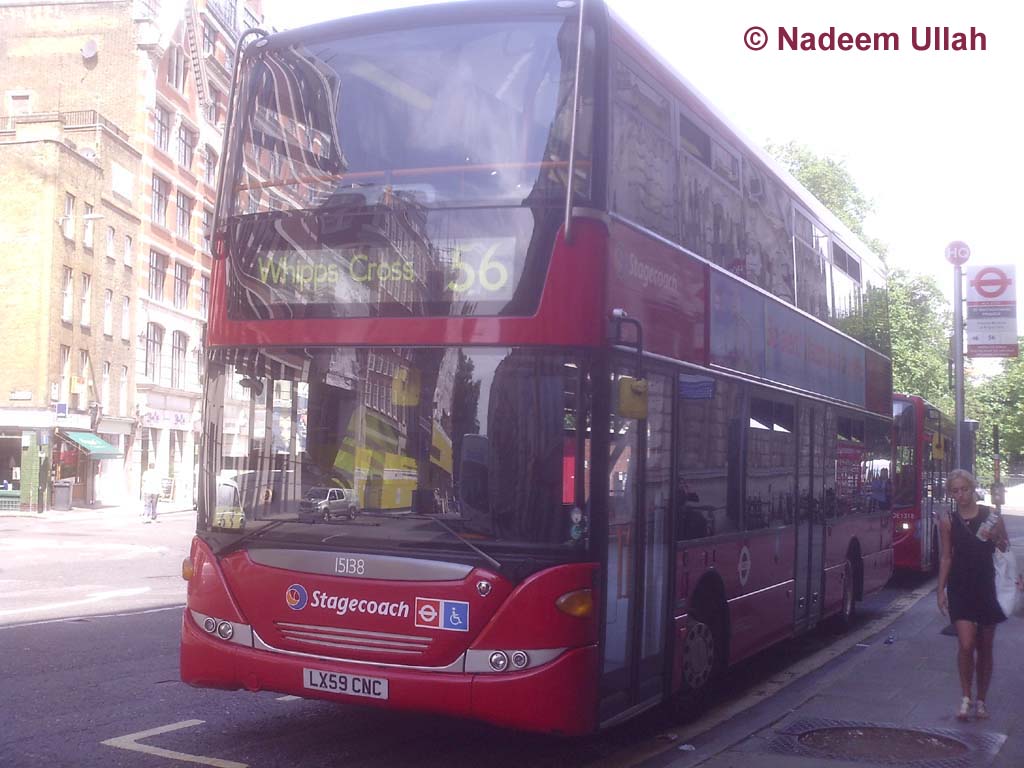 | Photo © Nadeem Ullah. |
Home | Bus routes | Operational details | Service changes | Operators & Garages | Photo gallery
As trunk routes go, the 56 is quite a new service, having started on 24 February 1990 replacing parts of the 38 and 277. The route has been changed little since its introduction, and buses continue to ply between Smithfield (St. Bart's Hospital) and Whipps Cross via Islington, Hackney Downs and Leyton Green.
Leyton garage, which runs the 56, was one of the first recipients of low floor double deckers. At the time, East London (which owns Leyton) was part of the Stagecoach group and they were able to accelerate the investment programme by purchasing buses to provincial specification so that they could be cascaded out of London later on. The company standardised on Tridents, mostly to the 10.5m length, but the first 98 were built to provincial specification, featuring low height bodywork and forward mounted spiral stairs. At this stage the builders also claimed to be unable to accommodate a rear window on the lower deck. The only non-Stagecoach feature is the fitment of a second door, which is essential for most London work. Outside London, low-height (4.2m) bodies are commonly specified as many bridges are just a little too low to accommodate full height (4.4m) buses. Most of the extra height is downstairs; bearing in mind the lower floor level on a low floor bus, the headroom downstairs is quite colossal, except to the rear where there are some steps up to the back seat.
The planned cascades did indeed largely taken place, and the 56 and other routes came to be operated by standard London specification buses, with individual "bucket" seats, extra legroom (fewer seats), full height bodywork with a rear window downstairs, and a straight staircase. The merits of the latter are rather doubtful – although it makes steps different shapes and sizes, a curved staircase has the advantage that passengers can lean against the stairwall on the way up and down, which makes them safer. And, obviously, it takes up less space!
However, the staircase remained in the forward position. LTB/TfL had been advocating a staircase amidships, coupled with the exit door placed immediately in front of the rear axle, the theory being to get boarding and alighting passengers as far away from each other as possible. The main counter-argument was that the forward staircase allows more seats by using the space over the front wheels, which are too high to accommodate seats; however this is not actually true, because seats can otherwise be accomodated under the stairs! Nevertheless, in my experience the forward staircase does give a much more practical lower deck layout; the earlier designs tended to be claustrophobic, and there were problems with people banging their heads under the stairs. Another factor was that the long distance from the entrance to the staircase could make it hard to get on when the bus was busy.
A big shock on 2006 was the disposal of Stagecoach's London bus business to Macquarie bank – not least because of an overinflated price being on offer, but also said to be partly because Stagecoach boss Brian Souter had had enough of the bureaucratic nightmare that is running buses in London. Nonetheless Stagecoach made a triumphant return in 2010, but not before Macquarie had deviated from Stagecoach's Trident policy and ordered, amogst other things, 174 Scania OmniCity double deckers. One of the routes to receive these was the 56, and 15138 (LX59 CNC) takes stand time at Smithfield (St. Bart's Hospital) on 7 August 2013.
 | Photo © Nadeem Ullah. |
Navigation
| Previous | Next | |
| Chronologically | 49 | 284 |
| Numerically | 55 | 57 |
Photo Gallery | Bus route list | Operational details | Service changes | Operators & Garages